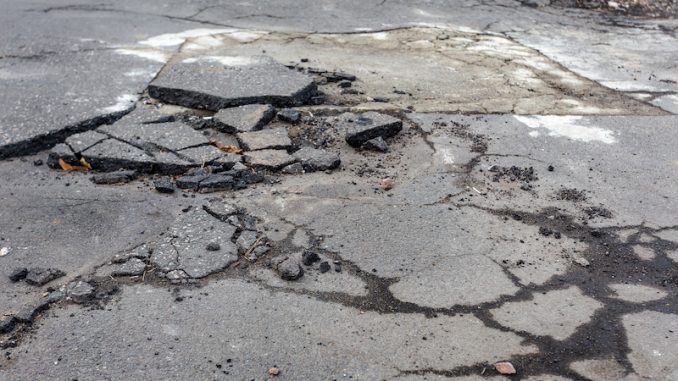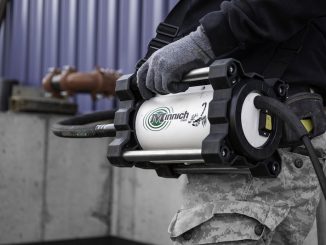
Over time, cracks often appear in pavement. There are many potential causes of cracks in asphalt concrete (AC) pavement, from lack of maintenance to weakened paver seams to improper pavement or base thickness. Repairing these cracks is critical to maintaining the viability of the roadway.
There are a number of ways to remediate pavement cracks. These may include surface treatments, crack sealing, resurfacing, and crack filling. To determine the appropriate course of action, a maintenance engineer or supervisor should conduct an evaluation of the pavement and/or cracks.
Evaluation of Pavement Cracks
The first step in any assessment should be a review of the pavement’s construction and maintenance records. These records should provide information regarding the age of the pavement, as well as its design, section boundaries, the type and extent of previous maintenance treatments, its condition rating, and the traffic and climate that it is subject to annually.
Second, a shoulder survey should be performed on a representative sample of the pavement section to determine the amount, type, and severity of the cracks. This survey should also examine the condition and effectiveness of any previous attempts at treating pavement cracks. The survey should note key features of the cracks, such as orientation, whether the cracks cup, lip, or fault, and the density of the cracks.
Once the evaluation is complete, the appropriate treatment must be selected. The best maintenance option will depend on the density and condition of the cracks. Chip seals, slurry seals, and similar treatments can be used if there are many cracks that do not have a high degree of edge deterioration. However, if there are fewer cracks but the cracks have a higher degree of edge deterioration, crack repair strategies may be necessary. This may include partial-depth patching or spot patching. Finally, if there are a moderate number of cracks with little to no edge deterioration at the edges, sealing or filling treatments may be effective.
If there are a large number of cracks or the cracks have severely deteriorated, then the pavement is in an advanced state of decay. In these situations, more extensive correction options will be necessary as crack sealing or filling will simply delay the need for these treatments. Similarly, if cracks have vertical distresses, such as cupping, lipping, or faulting, patching or milling may be required. These types of cracks can increase pavement roughness and deteriorate rapidly. However, if the amount of vertical distress is relatively minimal, a temporary crack treatment may be adequate.
Before selecting a type of maintenance, contractors should check with the appropriate highway agency. Most agencies have policies that specify the type of maintenance that should be performed on cracked pavements and when it should be performed.
The Objective of Treating Pavement Cracks
There are two primary treatments for treating pavement cracks: crack sealing and crack filling. Understanding the difference between the purpose and function of each treatment is crucial so that the best and most economical choice is selected for a given project.
Crack sealing involves placing specialized materials either above or into working cracks to prevent the intrusion of water into the crack. In contrast, crack filling involves placing ordinary treatment materials into non-working cracks to significantly reduce the infiltration of water and to reinforce the adjacent pavement. Crack sealing is both more difficult and costly to achieve than crack filling. It requires specially formulated materials, more planning, and the use of specialized equipment.
There are set criteria for determining whether a crack is working or non-working. Generally, this can be determined by the crack type. A working crack is usually transverse. However, some longitudinal and diagonal cracks may achieve the three millimeter movement criteria. Any material placed into a working crack must be capable of adhering to the crack sidewalls and flexing as the crack opens and closes. The preferred material for working cracks is a rubber-modified material that is designed for low-stress elongation, particularly at low temperatures.
Non-working cracks are usually diagonal cracks, longitudinal cracks, and some block cracks. In non-working cracks, little movement occurs. This is due to the close spacing between non-working cracks. This allows for the use of less specialized (and therefore less costly) materials to fill the crack.
Determining whether to seal or fill a crack can be a challenging question for a contractor. In many cases, transverse cracks are the first cracks to appear in pavement. It is possible for several types of cracks to appear at the same time. In that situation, the best option is to choose a treatment for the most demanding crack type and use it to fill all cracks.
The primary factor in deciding whether to seal or fill a crack should be the annual horizontal movement of the targeted crack type. Crack width may also be a consideration. As a general rule, working cracks with limited edge deterioration should be sealed, and non-working cracks with moderate or no edge deterioration should be filled.
Sealing cracks is a preventative maintenance activity that should preferably be performed after working cracks have developed. The ideal time to seal cracks is in the spring or fall when the temperatures are moderately cool. After these newly developed cracks are sealed, secondary cracks are minimized. Generally, transverse thermal cracks in asphalt concrete (AC) flexible pavements will appear between two to seven years after construction. Transverse reflection cracks in AC overlaid construction pavements will typically materialize between one and three years after the pavement is resurfaced.
Working in cool temperatures has two advantages when it comes to crack sealing. First, in cooler temperatures, the cracks are partially open so that a sufficient amount of material can be placed if cutting will not be performed. Second, the width of the crack channel is nearly at the middle of its working range, which will improve the performance of the sealant material.
Crack filling can be performed year-round, although it typically takes place in cool weather as the cracks are more open. In this weather, more material can be applied to the cracks. This treatment can either be preventative or routine. As with sealing, preventative crack filling should be performed shortly after non-working cracks have developed. This may occur as soon as four to eight years after construction or resurfacing. A durable filler material should be selected to reduce the number of applications necessary. This approach will also decrease maintenance costs, as the filling operation will not need to be performed repeatedly.
Understanding the nature of concrete cracks and the best methods for remediating them can help to ensure a successful pavement repair project. In the next article, we will explore planning and design of pavement repair work.
How do I determine the appropriate treatment for cracks in pavement, and what factors should be considered?
Conduct an evaluation of the pavement, considering factors like crack density, orientation, and edge deterioration, to choose between treatments such as chip seals, crack repair strategies, or sealing/filling based on the specific conditions.
What is the difference between crack sealing and crack filling in pavement repair, and when should each be employed?
Crack sealing prevents water intrusion into working cracks using specialized materials, while crack filling uses ordinary materials to reinforce non-working cracks; the choice depends on crack type, movement, and width, with sealing being more complex and costly.












































